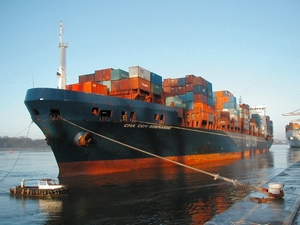MSC Napoli
 |
|
| History | |
|---|---|
| Name: | MSC Napoli |
| Owner: | Metvale Limited |
| Operator: | Zodiac Maritime Agencies Ltd |
| Port of registry: |
|
| Builder: |
|
| Yard number: | 1082 |
| Launched: | 24 August 1991 |
| Out of service: | January 2007 |
| Renamed: |
|
| Identification: |
|
| Fate: | Damaged in storm on 18 January 2007; beached on 19 January 2007; broken up on 20 July 2007. Finally removed in July 2009. |
| Notes: | |
| General characteristics | |
| Tonnage: | |
| Length: | 275.66 m (904.4 ft) |
| Beam: | 37.10 m (121.7 ft) |
| Draught: | 13.8 m (45 ft 3 in) |
| Installed power: | 34,480 KW |
| Speed: | 24 kn (44 km/h; 28 mph) |
| Capacity: | |
| Crew: | 31 |
| Notes: | |
MSC Napoli was a United Kingdom-flagged container ship that was deliberately broken up by salvors after she ran into difficulty in the English Channel on 18 January 2007.
The ship was built in 1991 and had a capacity of 4,419 TEU (62,000 tons). She was built by Samsung Heavy Industries, Kŏje, South Korea, owned by Metvale Ltd., a British Virgin Islands Brass Plate single entity company, managed by Zodiac Maritime, and was under charter to Mediterranean Shipping Company.
In 2001, then named CMA CGM Normandie, she was en route from Port Klang in Malaysia to the Indonesian capital, Jakarta when she ran aground on a reef in the Singapore Strait and remained stuck for several weeks. She was repaired by the Hyundai-Vinashin Shipyard in Khánh Hòa Province, Vietnam, which included the welding of more than 3,000 tonnes of metal onto the hull.
While en route from Belgium to Portugal on 18 January 2007, during European windstorm Kyrill, severe gale-force winds and huge waves caused serious damage to Napoli's hull, including a crack in one side and a flooded engine room. The ship was then 50 miles (80 km) off the coast of The Lizard, Cornwall.
At approximately 10:30 UTC, the crew sent out a distress call. Not long afterwards, the captain ordered the crew to abandon ship into one of the lifeboats. They were out at sea for several hours before all 26 crew were picked up from their lifeboat by Sea King helicopters of the Royal Navy's Fleet Air Arm and taken to Royal Naval Air Station Culdrose in Cornwall. During the difficult rescue, one helicopter broke two winch lines, making it even harder to rescue the seamen. The rough seas and gale-force winds gave the men acute seasickness, and in some cases dehydration due to overheating.
...
Wikipedia
